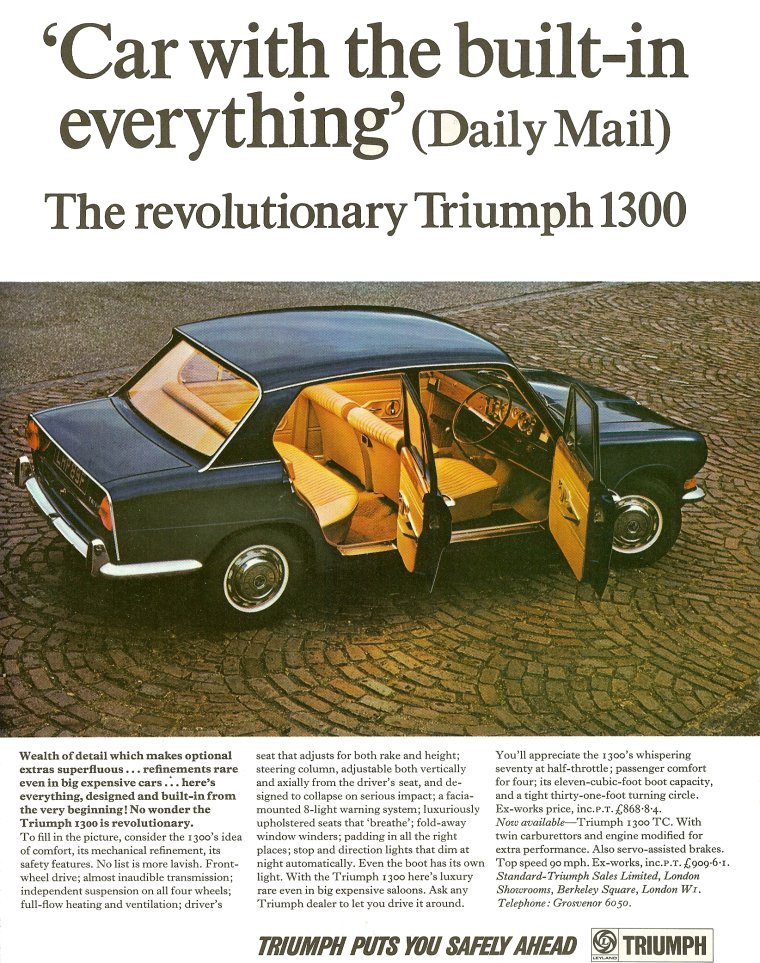Taking the fight up to
BMC Mini and
Austin/Morris 1100 was never going to be an easy job, and so Leyland's first foray into front-wheel-drive automobiles needed to be a good one.
The Triumph 1300 was designed as a replacement to the popular Herald, although Leyland had a bit of an each way bet by continuing manufacture of the rear-wheel-drive iteration until
1970.
Adding individuality to their car, the designers did not follow the BMC transverse layout, instead opting to mount the engine above the gearbox in a front-back configuration. That's not to say the existing parts bin was not used, as evidenced by the use of the
Triumph Herald 13/60's 1296cc engine, which was mated to a 4 speed all-synchro gearbox.
On the outside, the Triumph 1300 kept the family look in-tact, some commentators of the day describing it as a "squashed" version of the Triumph 2000. The rear end styling was particularly handsome, and in some respects looked almost Italian, the brightwork carrying over from the bumper to a garnish that ran up the two rear guards and along the rear of the boot lid.
Inside the Triumph 1300 could only be described as oppulent. There was full instrumentation, a wooden dashboard, wooden door cappings and an adjustable steering column that was adjustable not only up and down but back and forth as well. The contoured seats featured "ventilated" PVC upholstery and although they would not recline, the front seats were remarkably versatile and could be easily adjusted for height and rake.
Inside there was plenty of room, and the almost inaudible gearbox helped make the car not only look, but "feel", considerably more expensive that it actually was. The only blemish was the slightly baulky gearbox. There was plenty of standard kit too, including thick carpeting, a heated backlight, fold-away spring-loaded window winders, recessed door handles and even stop and direction lights that dimmed at night automatically.
The instrument cluster featured a speedometer, fuel gauge, temperature gauge, ammeter and a a fascia mounted 8-light warning system arranged in a circular formation. The rear seat had a centre armrest which could be folded up when not in use.
In
1968 a more sporting variant joined the lineup - the 1300TC. This later iteration featured twin SU carburetors which lifted power from 61 bhp (45 kW) to a more respectable 75 hp (56 kW), and could be identified by discreet badges. The TC's top speed was significantly higher than the 1300, and acceleration times cut accordingly.
So the question remains, did the Triumph engineers get it right? We think so, the Michelotti design blessed the car with a rakish and sporting appearance, while the oppulent British interior was a pretty good place to be. It would form the basis for the lusty
Dolomite range, and in TC form offered reasonable performance and good fuel economy. The 1300 would morph into the Triumph 1500 in August
1970, the new model using Triumphs enlarged 1493 cc engine which provided a useful increase in torque, but a decrease in overall power and worse fuel consumption. The front end was cleaned up considerably, and the rear redesigned with longer tail, providing a useful increase in boot space. Production of the front-wheel-drive Triumphs came to an end in
1973.

